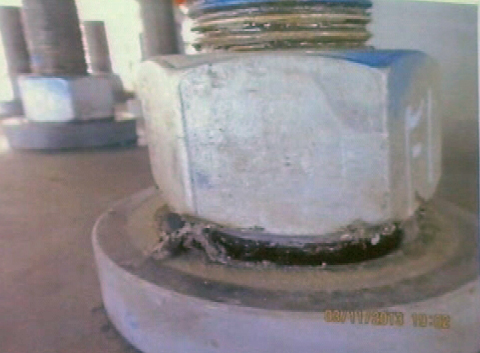At a Caltrans presentation on the Bay Bridge's bolt problem on Wednesday, officials said it was possible that if they didn't have answers to why the steel bolts snapped last month, they may not be ready to open the eastern span of the Bay Bridge on Labor Day.
The Metropolitan Transportation Commission was holding a meeting on the bolt problem, when Caltrans engineers announced it would be "guess work" if the Labor Day opening would hold firm.
Steve Heminger, executive director of the Metropolitan Transportation Commission, said a lot is unknown about how the defects occurred.
"Until we have the scope of what we're doing we can't know the schedule, and we don't know the budget," Heminger said, refuting previous reports that the fix could cost $1 million. "Our hope is that in the next few weeks we can bring a design to closure," he said.
Caltrans did say that a second batch of bolts on the new eastern span appears to be holding up after a first group of 32 bolts snapped. They also said that a group of steel rods made in 2010 has now been tightened and is not showing any signs of stress.
The bolts that snapped were made in 2008, and engineers suspect that hydrogen may have made the steel brittle. But engineers are still trying to get to the bottom of it.
The Ohio-based Dyson Corp. produced the rods that secure cables on the new bridge's tower. It also built parts used in the original Bay Bridge, which opened in 1936.

The defective parts were made in 2008 by Painesville, Ohio-based Dyson Corp., and officials say other parts made by the company on the span's single tower and another section have been inspected visually and are considered safe.
Those other parts made by Dyson are subjected to far less tension and pressure than the bolts that failed, said Tony Anziano, toll bridge program manager for the California Department of Transportation.
California Transportation Commission Chief Engineer Stephen Maller said the big question is how hydrogen got into the steel, and that it could take "a few weeks to a few months'' to devise a recommended fix.
One possible source of the hydrogen is rainwater, which could have somehow got into the holes the bolts were driven into, which engineers thought were watertight, Maller said. Another possibility is that the hydrogen was introduced at some point during the bolts' manufacture.
"When it was being designed, nobody thought this would happen,'' Maller said. "Water could have collected in these holes, but this may not be the failure mechanism at all.''
While some doubt was cast on the ability to have the bridge open on Labor Day, bridge officials say it's too early to know for sure.
That rankled Oakland Mayor Jean Quan, who said her city needs timely notification of any possible delay in the bridge's opening to help avoid impacts to local businesses, particularly hotels.
"There are millions of dollars at stake in hotel rooms. ... We need to set a date,'' Quan said. The mayor said if people can't properly plan for a delayed opening, it could "hurt the local economy.''
Officials aren't even sure yet if they'll have to replace the custom-made bolts to fit in a new "collar'' that would fit over the existing piece containing the broken pieces. The engineers also are looking at another option that would use a concrete fitting to help replace the lost load bearing.
"How long will it take to get the new bolts? We can't just go to Ace Hardware for these. They have to be fabricated,'' Heminger said.
All agreed that ensuring the bridge's safety was the most important goal, even if that means delaying the opening.
"If it means moving the bridge date back, that's what it means,'' said Bill Dodd, chairman of the toll oversight committee. "We're going to build a first-class bridge here.''

